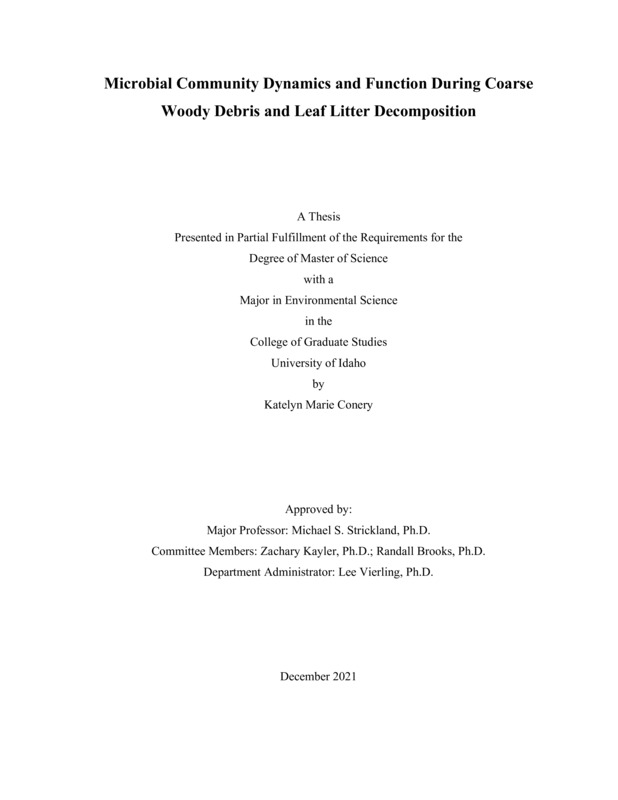Microbial Community Dynamics and Function During Coarse Woody Debris and Leaf Litter Decomposition
Conery, Katelyn. (2021-12). Microbial Community Dynamics and Function During Coarse Woody Debris and Leaf Litter Decomposition. Theses and Dissertations Collection, University of Idaho Library Digital Collections. https://www.lib.uidaho.edu/digital/etd/items/conery_idaho_0089n_12266.html
- Title:
- Microbial Community Dynamics and Function During Coarse Woody Debris and Leaf Litter Decomposition
- Author:
- Conery, Katelyn
- Date:
- 2021-12
- Embargo Remove Date:
- 2022-12-21
- Keywords:
- coarse woody debris decomposition leaf litter microbial community
- Program:
- Environmental Science
- Subject Category:
- Soil sciences; Microbiology; Ecology
- Abstract:
-
Nitrogen fertilization is a common soil amendment; however little is known about how surface and belowground wood decomposition are affected by N amendments. We analyzed data from a field study in Norrliden, Sweden where the mass loss of trembling aspen (Populus tremuloides Michx.) and loblolly pine (Pinus taeda L.) wood stakes was recorded for three years. Wood stakes were placed horizontally on the surface of the organic horizon and at the interface between the mineral and organic horizons and inserted vertically into the mineral soil in plots treated with different amounts of ammonium nitrate fertilizer (no nitrogen (control), 60 kg ha-1 (N1), 120 kg ha-1(N2)). Fungi colonizing the wood stakes were also analyzed. Mass loss was greater in the mineral soil for aspen and pine stakes compared to surface stakes and N treatment only affected stakes placed on the surface. Nitrogen treatment did not affect fungal richness, but it did affect fungal community composition. Overall, N treatment had minimal effect on coarse woody debris (CWD) decomposition and CWD decomposition appeared to be driven more by microclimatic conditions of the soil as related to soil depth. Microbial communities are important drivers of decomposition and the ability to link community structure to function will strengthen our understanding of their role in C and nutrient cycling. We used microcosms to study how seven different microbial communities sourced from areas with different vegetative cover decomposed the same litter by recording mass loss, respiration, and total volatile organic compound (VOC) production weekly for 12 weeks. We sampled microbial community composition at four time periods during the 12-week study. Mass loss was more related to fungal community as a whole while respiration and total VOCs were more related to the fungal class Sorardiomycetes. Microbial communities remained compositionally distinct throughout the study and were related to differences in decomposition, respiration, and total VOC production, suggesting that microbial communities are not functionally redundant. Because of the differences observed in total VOCs and community composition, we propose that microbial community structure could be studied via VOC production.
- Description:
- masters, M.S., Environmental Science -- University of Idaho - College of Graduate Studies, 2021-12
- Major Professor:
- Strickland, Michael
- Committee:
- Brooks, Randy; Kayler, Zachary; Vierling, Lee
- Defense Date:
- 2021-12
- Identifier:
- Conery_idaho_0089N_12266
- Type:
- Text
- Format Original:
- Format:
- application/pdf
- Rights:
- In Copyright - Educational Use Permitted. For more information, please contact University of Idaho Library Special Collections and Archives Department at libspec@uidaho.edu.
- Standardized Rights:
- http://rightsstatements.org/vocab/InC-EDU/1.0/

